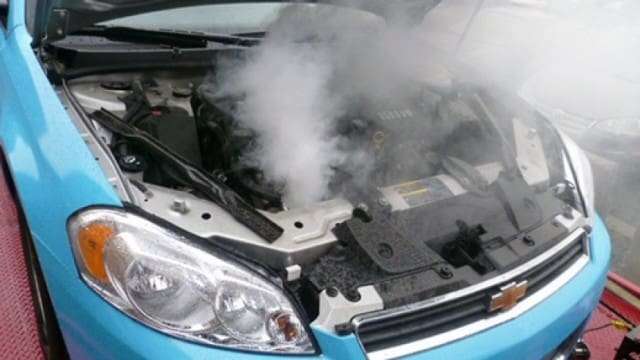
The (ECT) sensor, is an engine management system sensor. And, is used to monitor, the temperature of the engine’s coolant.
The tip of the (ECT) sensor, protrudes into one of the cooling system passages, and is immersed in coolant.
Most (ECT) sensors operate using electrical resistance to measure, the temperature of the coolant.
A typical (ECT) Sensor is a Negative Temperature Coefficient (NTC) thermistor. Because, its electrical resistance, decreases when the temperature increases.
The engines computer receives this signal. So, changes can be made to the engine’s timing and fuel calculations, for optimal performance. Consequently, engines need more fuel when they are cold, and less fuel when they are warmed up.
The computer will also scale back engine performance settings, if it detects that the engine temperature is too high.
So, it can protect the engine from possible damage, due to overheating. Engine temperature plays, such a vital role in engine performance calculations. Therefore, any problem with the (ECT) sensor, can quickly translate into engine performance issues.

How Does The (ECT) Sensor Work
An (ECT) sensor is connected to the main computer or (PCM). The (PCM) supplies a reference voltage (typically 5 Volt) and constantly monitors the (ECT) sensor signal. Based on this signal, the (PCM) adjusts the engines performance. It also operates the electric cooling fans, when the temperature reaches, a predetermined level.
If the signal from the (ECT) sensor is missing, or it is outside of the expected range. Then, the (PCM) turns on the (CEL), and stores the related trouble code in its memory. Common codes include, P0117 and P0118.
What Can Go Wrong With The (ECT) Sensor
One of the common problems is when the sensor has, a poor connection inside or in the connector. This causes interruptions in the signal to the (PCM), and the (PCM) sets the fault.
In some vehicles, symptoms of this problem show up as, erratic readings on the temperature gauge:
- The engine may run in fail safe mode.
- Air conditioner may stop working.
- Radiator fans may run constantly.
Consequently, many fault codes referring to the (ECT) sensor, could also be caused by other reasons. Such as a bad thermostat or issues with the cooling system, including even a leaking head gasket. Therefore, the problem must be properly diagnosed.
So, the tip of the sensor, has to be immersed in coolant. Consequently, a low coolant level inside the cooling system, can cause the signal from the sensor to be incorrect.
Always check the coolant level first. Next, the (ECT) sensor connector, must be checked for damaged pins or corrosion. There are several ways to test the (ECT) sensor, you can find the correct way in the service manual.
Engine efficiency, power and fuel economy all improve, as the engine temperature rises. Ideally, the engine will run as hot as possible, without boiling its coolant or damaging its components. But, a faulty (ECT) sensor can, cause havoc on an engine or its related systems.
Common Failure Signs
Usually A Problem With The (ECT) Sensor, Will Show Some Failure Signs:
- Poor Fuel Economy
- Black Smoke From Exhaust
- Engine Overheating
- Check Engine Light (CEL) Coming On
- Poor Engine Performance Or Stalling
- Increased Emissions
Poor Fuel Economy
One of the first signs, associated with a problem with the (ECT) sensor, is poor fuel economy. A failed (ECT) sensor can send a false signal to the computer, and throw off the fuel and timing calculations. It is not uncommon for the (ECT) sensor to fail, and send a permanently cold signal to the computer.

This will cause the computer to think the engine is cold, even when it is not. Once the engine is warm, it switches to relying on the oxygen (O2) sensors, for a more precise reading. A failed (ECT) sensor can prevent this change from happening, resulting in a rich running engine, and poor fuel economy.
Black Smoke From Exhaust
Another sign of a possible problem with the (ECT) sensor is, black smoke from the vehicle’s exhaust. A failed sensor can also send, a cold signal to the computer.

Consequently, confusing the computer, and causing it to unnecessarily enrich the fuel mixture. If the fuel mixture becomes excessively rich, the fuel cannot be adequately burned. As a result, it will burn up in the exhaust pipes, and cause black smoke.
Engine Overheating
Another sign of a problem with the (ECT) sensor, is an overheating engine. The (ECT) sensor can also fail in a manner, that causes it to send a permanently hot signal. As a result, causing the computer to incorrectly compensate for a lean signal.

All of which can result in overheating, and even misfires or engine ping. Also, it may not slow the ignition timing, and turn on the cooling fans when necessary. Finally, causing the engine to overheat.
Check Engine Light (CEL) Coming On
The (CEL) is another sign, of a potential problem with the (ECT) sensor. In many, but not all vehicles, the computer can set off a (CEL). Usually, if it detects a problem with the sensor’s signal or circuit.
Poor Engine Performance Or Stalling
Your engine requires more fuel, when it is first started when cold. But, if it does not get the fuel, it will not idle smoothly. The signal from the (ECT) sensor tells the engine’s computer, when to apply extra fuel, during a cold start.
A faulty sensor can confuse the computer, keeping it from providing enough fuel. As a result, the engine may hesitate, stall, misfire or have poor engine performance.
Increased Emissions
If the sensor sends a faulty “cold” reading, the engine will run rich. As a result, carbon monoxide emissions will increase, and possibly hydrocarbons, as well.

In contrast, if it sends a faulty “hot” reading, the engine may misfire and run rough, increasing hydrocarbon emissions.
How To Take Care Of Your (ECT)
Use These Tips To Help Stay Ahead Of Problems:
Do Not Use Tap Water To Refill The Radiator Or The Coolant Reservoir:
- Tap water contains elements of rust, and other minerals, that might prove harmful in the long run. Especially, when the water boils, and evaporates inside the radiator.
- Coolant prevents the water from boiling. And, also lubricates the engine block, and the radiator, preventing rust formation.
Keep On Top Of Any Leaks:
- Fix oil leaks or gasket leaks immediately. Because, if oil leaks into the coolant, they do not mix. As a result, reducing the service life of the (ECT) sensor.

- Fix coolant leaks immediately. The cooling system in your vehicle, is a sealed system. It is unusual if you constantly need to refill the coolant tank with water. Consequently, if there is not enough coolant in the system, the (ECT) sensor might get false readings.
Conclusion
The (ECT) sensor is one of the, most important engine management sensors. Because, the (ECT) sensor is a crucial component, for making sure that your engine performs at an optimal level. For this reason, if you suspect that your (ECT) sensor is having an issue, replace it.
BY DANNY BENDER




